 |
The
Eiffel Tower
|
|
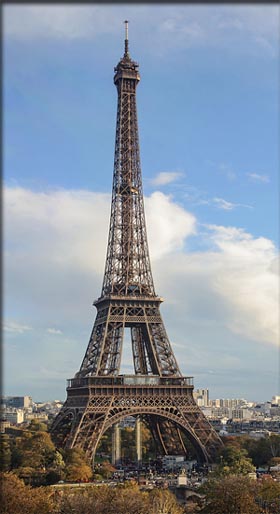
By
Photo: Myrabella / Wikimedia Commons, CC BY-SA 3.0, https://commons.wikimedia.org/w/index.php?curid=26376691
|
When construction was first started in 1887, it
was called "useless and monstrous" as well as a "ghastly dream."
Yet this structure has become one of the most beloved icons
of a major city and a wonder of the age of steam.
This most French of all buildings was actually
inspired by an artifice from the New World. In the early 1880's,
Maurice Koechlin and ╔mile Nouguier, two engineers working at
the design firm of Gustave Eiffel, were thinking about what
the centerpiece of the proposed 1889 World's Fair in Paris should
look like. They had heard about a tower in New York City called
the Latting Observatory that had been built as part of the 1853
Exhibition of the Industry of All Nations. The Latting Observatory,
a wooden octagon-shaped structure, at 290 feet high had been
the tallest building in New York for the three years it had
existed until it burned down. Visitors could climb its heights
and get an unobstructed view of the city from its observation
platform.
Koechlin and Nouguier brought their idea to Eiffel,
who authorized further study. While the Latting engineers had
paid little attention to the look of their tower, the French
engineers considered the form and beauty of the structure to
be a paramount consideration. Koechlin drew a sketch of it which
he described as "a great pylon, consisting of four lattice girders
standing apart at the base and coming together at the top, joined
together by metal trusses at regular intervals." Other members
of Eiffel's company added the idea of decorative arches to the
base of the tower and a glass pavilion at the first level.
Minister for trade, ╔douard Lockroy, supported
Eiffel's proposition and altered the rules of the design competition
for the fair's centerpiece to favor the tower. In June of 1886,
it was selected as the winner.
|
Seven
Quick Facts
|
| -Height:
984 feet (300m). With modern antenna 1,063 feet (324
meters). |
| -Construction:
January 1887 - March 1889. |
| -Designer:
Gustave Eiffel. |
| -Made
of: 7,300 tons of wrought iron. Total weight: 10,000
tons. |
| -Maintenance:
50 to 60 tons of paint are required to coat the tower
every seven years. |
| -Opening:
May 15th, 1889 |
| -Other:
Second highest structure in France after the Millau Viaduct.
|
Protest
Against the Tower
Although Lockroy liked the design of the tower,
many people in Paris did not. In 1887 a group of influential
artists and architects got together and wrote an open letter
to the Commissioner for the Exposition, Charles Alphand, denouncing
the idea:
We, writers, painters, sculptors, architects
and passionate devotees of the hitherto untouched beauty of
Paris, protest with all our strength, with all our indignation
in the name of slighted French taste, against the erection [...]
of this useless and monstrous Eiffel Tower [...] To bring our
arguments home, imagine for a moment a giddy, ridiculous tower
dominating Paris like a gigantic black smokestack, crushing
under its barbaric bulk Notre Dame, the Tour Saint-Jacques,
the Louvre, the Dome of les Invalides, the Arc de Triomphe,
all of our humiliated monuments will disappear in this ghastly
dreamů
Construction
|
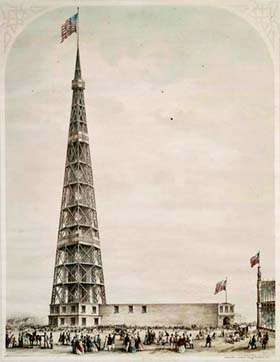
The
Latting Observatory in New York.
|
Despite their protests, construction commenced
on January 28th, 1887. While some critics didn't like shape
of the tower, others were concerned that it could not be finished
by the opening of the fair, or that it would be impossible to
build at all. It would be, after all, the tallest building in
the world when finished with a height of 986 feet (300m). The
previous record holder, the Washington Monument, was only about
half the height of Eiffel's proposed tower. What's more, the
Washington Monument was a traditional masonry structure (made
of brick or stone), while Eiffel's structure would be made of
wrought iron, a huge departure from previously known and trusted
methods of construction of such tall edifices.
Eiffel's team, however, were experienced bridge
builders, and since the tower construction used many similar
materials and techniques, they were certain of their ability
to finish the erection in time. The architectural firm created
1,700 general drawings of the tower and 3,629 detailed drawings
of the 18,038 different parts that needed to be built. All parts
were created at a factory in the Paris suburbs and brought to
the site via horse-drawn wagons where they were bolted together.
Nothing was created on location at all and if a part didn't
fit, it was sent back to the factory to be altered.
The first thing that had to be done to build,
before the first iron section of the tower arrived, however,
was to pour four massive concrete foundations, one to support
each of the tower's huge legs. The support for the east and
south legs, farthest from the River Seine, went in relatively
easy. They were 7 feet thick (2m) and well supported by firm
ground. The west and north foundations, however, were near the
river on softer, wetter ground. Here it was necessary to build
two compressed-air caissons that went down to a depth of 72
feet (33m) to keep the water out as the ground was excavated
and the concrete poured. On top of each slab of concrete a huge
block of limestone was installed. These limestone blocks, cut
at an angle at the top, provided a place for the tower's metal
feet to rest.
|
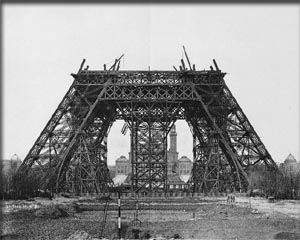
The
first level under construction in March of 1888.
|
By the end of 1887, construction of the four metal
legs of the tower was well underway. Gigantic hydraulic jacks,
capable of pushing with the force of 800 tons, were installed
at each of the bases, allowing the legs to be pushed into position
so they would join at precisely the right way at the first platform
189 feet (58m) above the ground.
As the construction continued, the lifting of
new parts into place on the tower was done by four small cranes,
one installed on each leg. As the tower grew, the cranes were
designed to "creep" up the legs so they would always be in a
position to lift new parts into place.
The first level was finished by March of 1888
and the second level - 379 feet (116m) - just a few months later
in August. The tower was completed in March of the following
year when the flagpole was installed 984 feet (300m) above the
ground. Visitors could go as high as the observation deck at
the top level of the tower which was 906 feet (276m) above the
ground. Today, the top of the tower (with a modern radio antenna
installed) is at 1,063 feet (324 meters).
Though many doubted Eiffel's ability to complete
the tower on time (one tabloid newspaper headline had reported
"Gustave Eiffel Has Gone Mad: He Has Been Confined in an Asylum"
during a temporary halt in construction), the erection of the
tower went smoothly and only required 300 workers at the site.
Amazingly, due to Eiffel's careful use of equipment like guardrails
and screens, only one man was killed during the undertaking,
an incredible safety record for a big 19th century project.
Stairs
and Elevators
|
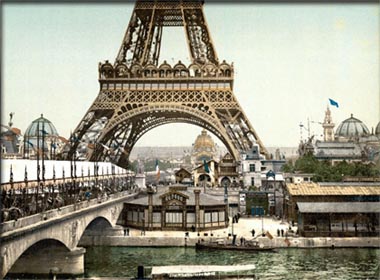
The
tower in its original function as a gateway to the 1889
World's Fair in Paris.
|
Though many visitors chose to climb the stairs
up the legs to the first and even second levels, it was clear
that elevators would be needed to handle much of the fair traffic.
Elevators were installed in two of the legs to carry visitors
from the ground to the first level. These were relatively simple
in design because despite traveling at an angle, the tracks
they rolled on were straight. More complicated were the pair
of elevators that took visitors from the first to the second
level as the curve in the tower legs at this point made the
use of straight tracks impossible. The problems were so significant
that no French firm wanted to take on the project. The commission
overseeing the tower had to abandon their requirement of only
using French contractors and go to the American firm, Otis,
to get the job done. For the final leg of the journey up the
tower, a pair of elevators worked together to get visitors from
the second to the third level. Passengers were required to change
cabs at a halfway point.
When the tower was competed, it weighed approximately
10,000 tons. Of that, 7,300 tons were composed of wrought iron.
There are 328 steps to the first level of the tower and 669
from the base to the second level. There is a staircase to the
top level which involves an additional 996 steps, but tourists
are only allowed to access the first and second levels by stairs.
An elevator must be used for the trip to the top.
At the very top of the structure, Gustave Eiffel
maintained an office for many years where he received guests
and did meteorological observations. The office is still viewable
by visitors and contains a mannequin of Mr. Eiffel.
|
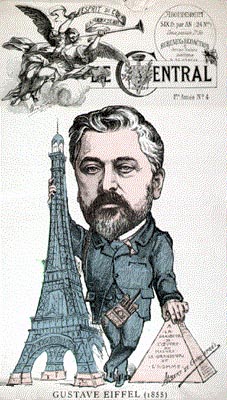
A
caricature of Gustave Eiffel drawn on the occasion of
him comparing his tower to the Pyramids.
|
For such a large structure built in the 19th century,
the Eiffel Tower deals very well with the wind. Eiffel himself
commented "Now to what phenomenon did I give primary concern
in designing the Tower? It was wind resistance." Even in the
strongest winds, the tower only sways 2 to 3 inches (6-7cm),
remarkably little for such a tall edifice.
The tower was only supposed to be in operation
for 20 years. After that, the ownership was to revert to the
city of Paris which had plans to disassemble it in 1909. However,
it proved so useful for communications, it was allowed to remain
standing. Eventually it became such a well-known icon of the
city, no Parisian today would ever consider taking it down.
During World War II when the Germans occupied
the city, Hitler ordered that the tower, along with many other
historic buildings in the city, be blown up if his army was
forced to abandon the area. Fortunately, General Dietrich von
Choltitz, the military governor of Paris, disobeyed Hitler's
orders and the historic monument was preserved. So the tower
remains in position even today, an iconic symbol of a world-class
city.

Copyright Lee Krystek
2016. All Rights Reserved.